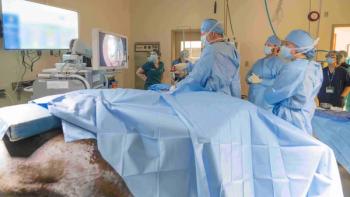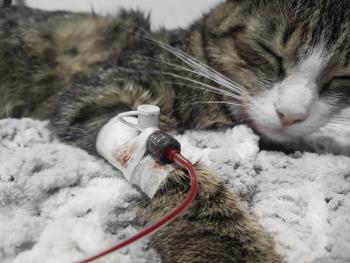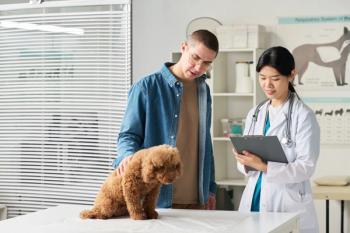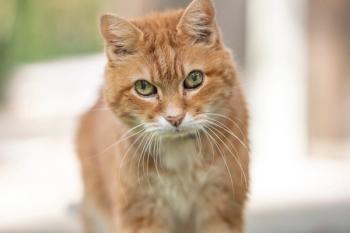
Elbow dysplasia (Proceedings)
Elbow dysplasia is a collective term for the developmental orthopedic diseases of the canine elbow. Traditionally, it refers to ununited anconeal process (UAP), osteochondrosis of the humeral condyle (OCD), and fragmentation of the medial coronoid process (FCP).
Elbow dysplasia is a collective term for the developmental orthopedic diseases of the canine elbow. Traditionally, it refers to ununited anconeal process (UAP), osteochondrosis of the humeral condyle (OCD), and fragmentation of the medial coronoid process (FCP). Recently, some authors have included elbow joint incongruity and diseases such as ununited medial epicondyle in this group as well. While all of these diseases are grouped under the same syndrome, and multiple may be diagnosed simultaneously in a single joint, it is likely that the etiopathogenesis of each is distinct from the other. It is our lack of knowledge of the precise causes of developmental elbow diseases that allow them to be grouped as one syndrome.
Pathophysiology
The inciting events for the development of elbow dysplasia are unclear. General agreement exists that some form of joint incongruity or instability is a predisposing cause. The most popular incongruity theories relate to "ulnar notch/humeral condylar incongruity" and "radioulnar incongruity". Ulnar notch incongruity has been subjectively visualized on clinical radiographs, and theorized to concentrate forces at the anconeal process and coronoid process of the ulna, thus potentially predisposing to both UAP and FCP. Breed variability of the radiographic shape of the ulnar notch has been described, and some degree of physiologic incongruity has been demonstrated to be normal. It is unclear how much of a role ulnar notch incongruity plays in elbow dysplasia.
Radioulnar incongruity is characterized by either a relatively short radius or short ulna. A short radius has been experimentally shown to cause force concentration on the medial coronoid process, which may lead to FCP. In contrast, a shortened ulna could cause increased pressure on the anconeal process, resulting in UAP. Both a shortened radius and shortened ulna are seen clinically, and may lead to FCP or UAP respectively. However, neither appears to be necessary for development of FCP and UAP. Further, neither defect would be sufficient to explain the development of both FCP and UAP in the same joint.
In an attempt to overcome the limitations of the linear model of radioulnar incongruity, a three-dimensional model of incongruity recently has been proposed. The "angular vector model" describes potentially complex three-dimensional adjustments that may occur in the growing animal as a result of either a relatively short radius or short ulna. While it currently lacks objective supporting data, this theory is appealing, as it attempts to move beyond a two-dimensional model for elbow dysplasia. A three-dimensional understanding of the joint is also an important concept for evaluating the effectiveness of corrective osteotomies in addressing elbow joint incongruity.
Diagnosis
The first step in diagnosing elbow dysplasia is a thorough gait evaluation and physical examination. The dog should be made to walk and trot, both toward and away from observers. Lameness may be obvious, or it may be more subtle, visible only as a mild head-bob. Remember that the head-bob goes up when the dog is weightbearing on the lame side, and down when bearing weight on the sound side. In the most subtle cases, dogs may appear sound when moving, but tend to shift weight off of the affected leg when standing still. Dogs with bilateral elbow disease may appear relatively symmetrical in their gait, without an obvious head-bob or lamenesss.
On initial examination, dogs should be evaluated for forelimb muscle atrophy, due to chronic disuse. Joint effusion may be present, and typically is most palpable in the caudolateral compartment of the elbow. In addition, the joint may feel thickened, especially in chronic cases. On manipulation, decreased range of motion (max extension <165 and/or max flexion >40) may be evident. Discomfort and crepitus may also be present. Dogs with elbow dysplasia are most commonly painful on full flexion of the elbow. Hyperextension, with direct palpation on the olecranon can elicit pain in dogs with UAP. Supination of the antebrachium with the elbow in 90 of flexion, as well as direct palpation of the medial coronoid process can elicit discomfort in a dog with FCP. If physical examination is equivocal in isolating lameness to the elbow joint, imaging studies such as nuclear scintigraphy may be useful. These studies may help to rule out pathology in other joints as well.
Radiographic examination is integral for diagnosis and treatment planning. UAP is most easily diagnosed on a flexed lateral radiograph as a radiolucent line through the anconeal process. A standard anterior-posterior radiograph typically is sufficient for diagnosing OCD of the humeral condyle. The lesion most commonly is visible as a subchondral concavity with accompanying sclerosis in the medial aspect of the condyle. While standard radiographic studies typically are sufficient for diagnosing UAP and OCD, they are less sensitive for diagnosing FCP. Commonly, the only abnormalities evident for dogs with FCP are secondary changes such as osteophytosis and subchondral sclerosis. In a significant number of dogs with FCP, radiographs are normal.
Cross-sectional imaging techniques are being increasingly utilized to diagnose elbow disease in cases where radiographic findings are non-diagnostic. Both MRI and CT have been demonstrated to be more sensitive than radiographs in diagnosing FCP. Several studies have also evaluated the use of these techniques in evaluating elbow incongruity. However, currently direct observation via arthroscopy remains the most valuable test for diagnosing disease of the medial coronoid process or elbow joint incongruity. In addition to its value as a diagnostic test, arthroscopy has the added benefit of being a therapeutic intervention.
Treatment
The lack of clarity regarding the etiopathogenesis of elbow dysplasia has lead to debate over the optimal treatment of each individual disease. In general, early intervention before progression of significant degenerative joint disease probably gives the best prognosis for improvement. However, which intervention is indicated is often unclear.
Good results have been reported for treatment of UAP by fragment removal. Concerns over instability caused by removal of the anconeal process have raised questions regarding this technique. Consequently, lag screw fixation of the fragment, in combination with ulnar osteotomy to relieve abnormal pressure on the anconeal process has been recommended. Good results have been reported with this technique as well, in spite of progression of osteoarthritis in many cases.
OCD lesions of the medial aspect of the humeral condyle are typically treated by flap removal and curettage via arthroscopy or arthrotomy. Flap removal and healing of the defect with fibrocartilage appears to decrease discomfort and lameness. However, progression of osteoarthritis is typical. Recently, cartilage resurfacing via osteochondral autograft transfer has been reported in the humeral condyle. This may emerge as a viable treatment for humeral OCD.
Newsletter
From exam room tips to practice management insights, get trusted veterinary news delivered straight to your inbox—subscribe to dvm360.




